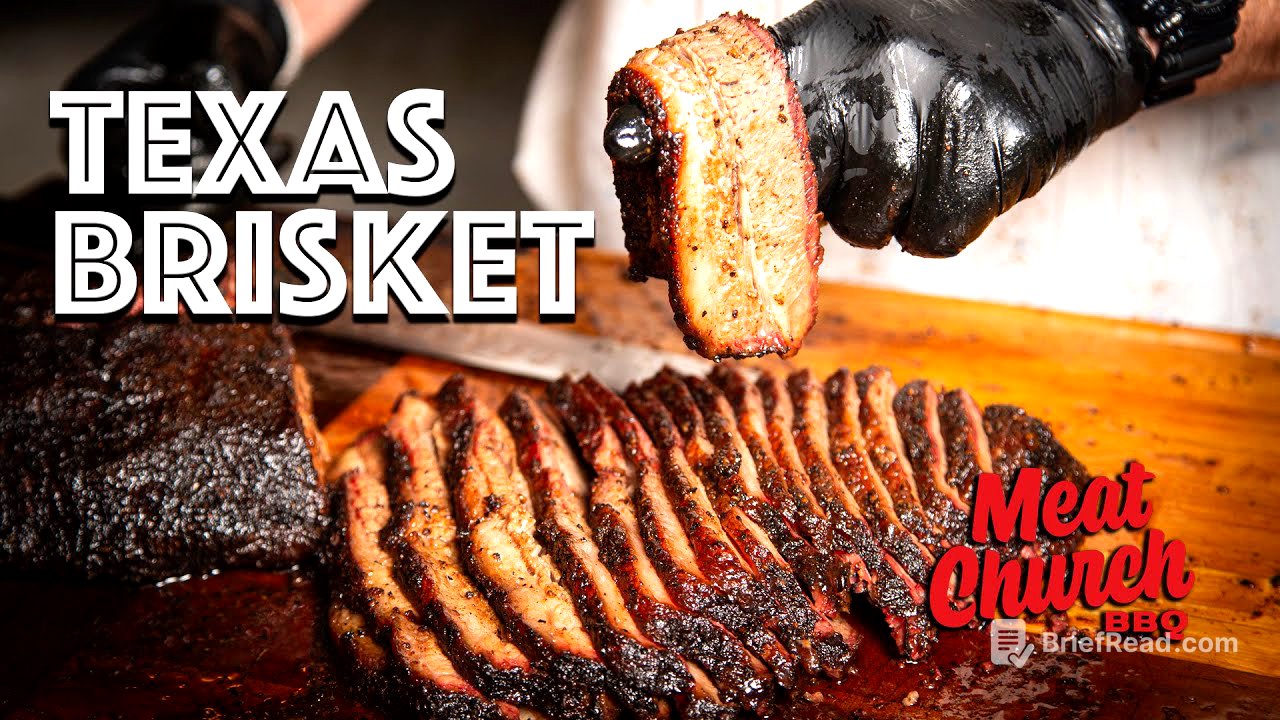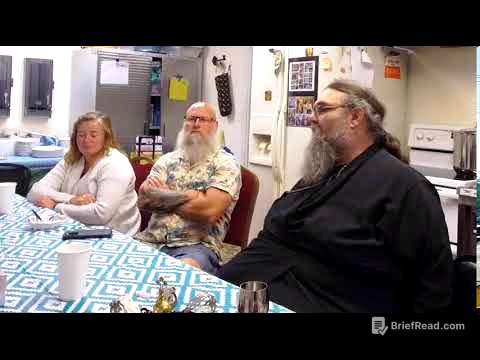TLDR;
This video demonstrates how to cook a Texas-style brisket, emphasizing traditional methods and flavors. Matt from Meat Church BBQ guides viewers through trimming, seasoning with a blend of Holy Cow and Holy Gospel rubs, smoking overnight at 225°F, wrapping in butcher paper when the bark and color are right (around 165-170°F internal temperature), increasing the temperature to 250°F, and cooking until probe tender (around 203°F). The video also covers fire management, resting the brisket, and slicing techniques for both the flat and point.
- Brisket is seasoned with a 2:1 ratio of Holy Cow to Holy Gospel rub.
- The brisket is smoked fat-side up, a traditional Texas method.
- Wrapping occurs when the brisket reaches 165-170°F and has a good bark.
- Resting the brisket is crucial for optimal tenderness and juiciness.
Introduction to Texas Brisket [0:00]
Matt introduces the video as a guide to making Texas barbecue brisket. He emphasizes the use of Texas-sourced products, including 44 Farms brisket, Meat Church's craft barbecue seasoning, a handmade smoker from Lockhart, and post oak wood. The brisket has already been trimmed to save time, but Matt mentions a separate video on the Meat Church channel that details the trimming process. He commits to an overnight, low-and-slow cooking process to honor the tradition of Texas barbecue.
Seasoning the Brisket [1:46]
Matt details his seasoning process, using a 2:1 ratio of Holy Cow to Holy Gospel seasoning. Holy Cow is primarily salt and pepper with some garlic. He applies the seasoning to the meat side first, then flips the brisket to repeat the process on the fat side. No binder is used, as the brisket is already moist. He seasons from about a foot to 18 inches high to ensure even application. After seasoning, the brisket sits for about 20 minutes to allow the seasoning to adhere and draw out moisture.
Setting Up the Smoke [4:32]
Matt explains his two-step cooking process: smoking the brisket low and slow overnight at 225°F, then wrapping it the next morning when it reaches 165-170°F and has a good bark. After wrapping, he increases the temperature to 250°F until the brisket is probe tender. He notes that while he often cooks brisket at 275°F to expedite the process, he's opting for a lower temperature for this overnight cook. He places the brisket in the smoker with the point toward the firebox, using post oak for fuel.
Managing the Fire [6:04]
Matt discusses the importance of maintaining a clean fire, indicated by thin blue smoke, for good barbecue. He explains how to make small temperature adjustments using the stack and larger adjustments using the firebox door. Opening the door provides more oxygen and helps the fire burn hotter. He emphasizes that managing the fire should be a relaxing process.
Wrapping the Brisket [6:57]
After an overnight cook at 225°F, Matt checks the briskets, noting they're around 165-170°F. He spritzes unwaxed butcher paper with cider vinegar to make it more pliable, then wraps the briskets tightly. The key is the color and internal temperature of the brisket, not necessarily the time. The briskets have been cooking for about seven to eight hours. After wrapping, he increases the smoker temperature to 250°F to finish the cook, estimating it will take another three to four hours.
Monitoring and Resting the Brisket [9:40]
Matt checks on the wrapped brisket, noting the paper is wet from the rendered fat. He doesn't find it necessary to add tallow, as it can make the bark soggy. He probes the brisket through the paper, finding it around 180°F. Later, he confirms the brisket is done by probing it and feeling its flexibility, indicating it's around 203°F. He explains the importance of resting the brisket. If serving within an hour, it can rest at ambient temperature; otherwise, it should be placed in a dry cooler to hold for a longer period.
Slicing and Serving the Brisket [11:22]
After resting the brisket for about 45 minutes, Matt unwraps it and prepares to slice. He separates the flat from the point and slices the flat into number-two pencil-sized slices, demonstrating the juiciness and tenderness. For the point, he rotates it to slice against the grain into wider pieces, which helps the fattier meat hold together. He emphasizes the perfectly rendered fat and the combination of flavors from the seasoning and post oak smoke.









